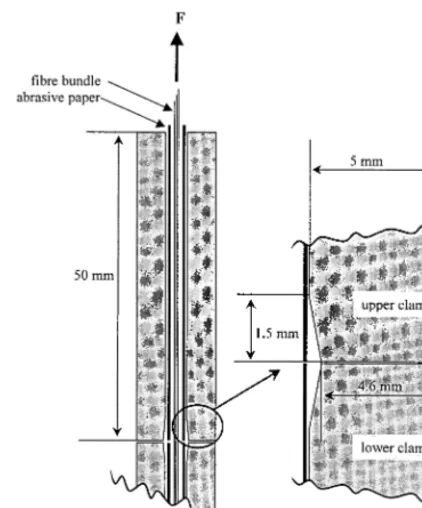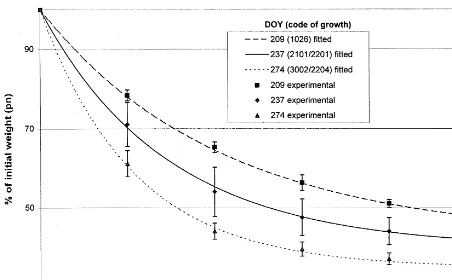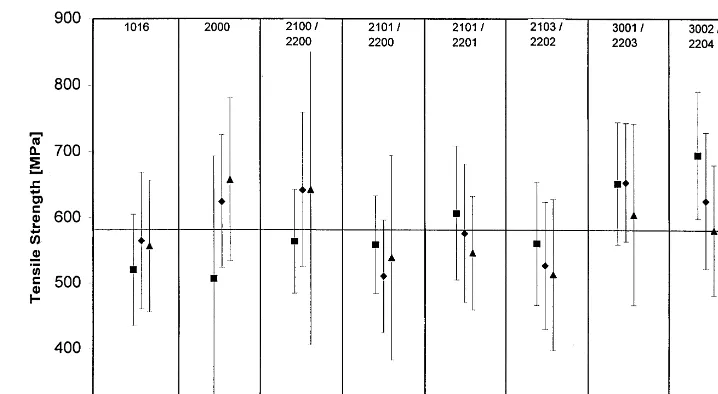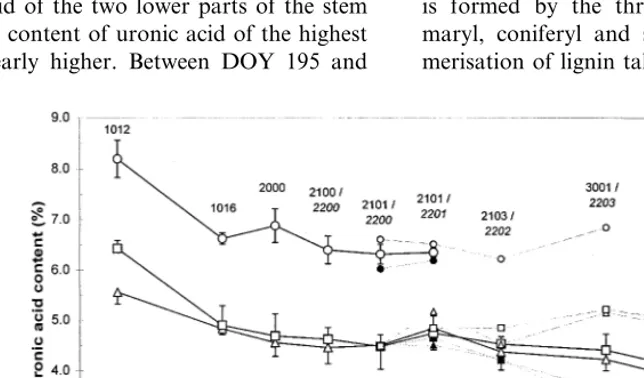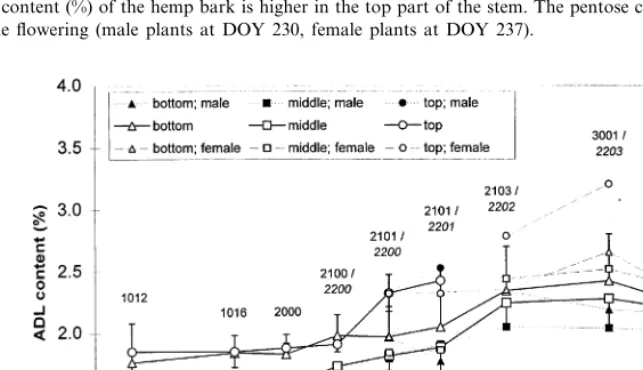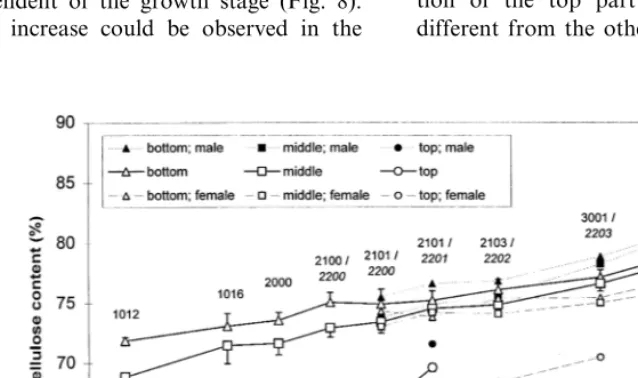Influence of the growth stage of industrial hemp on
chemical and physical properties of the fibres
A. Keller
a,*, M. Leupin
b,1, V. Mediavilla
b, E. Wintermantel
caSwiss Federal Research Station for Agricultural Economics and Engineering(FAT),8356Ta¨nikon b.Aadorf,Switzerland bSwiss Federal Research Station for Agroecology and Agriculture(FAL),8046Zu¨rich-Affoltern,Switzerland cETH Zu¨rich,Biocompatible Materials Science and Engineering,Wagistrasse23,8952Schlieren,Switzerland
Received 6 January 2000; received in revised form 16 March 2000; accepted 31 March 2000
Abstract
Fibre damages by the decortication process have to be avoided to achieve high quality of hemp fibres (Cannabis sati6aL.) for industrial use. In addition, a well-defined separation of the single fibres by the subsequent degumming
process is required. The objective of the present study is to determine the growth stage at which bark and shives can be separated from unretted industrial hemp (variety ‘Kompolti’) with as little fibre damage as possible. Furthermore, the chemical composition of the bark and the molecular weight of fibre cellulose have been analysed to estimate the fibre quality that can be achieved after a degumming process. For this, the fibres have been extracted by a standardised chemical degumming process. The investigations were carried out at nine growth stages of the plants reaching from vegetative stages to senescence. Considering only the mechanical decortication of green dry stems without degumming of the bark, the results reveal that a harvest time at the beginning of seed maturity leads to easier decortication without any effect on the tensile strength of the bast. For decortication of fresh stems including a subsequent degumming process, a harvest after the flowering of the male plants results in fibre losses during decortication and to fibres of reduced fineness. © 2001 Elsevier Science B.V. All rights reserved.
Keywords:Cannabis sati6aL.; Growth; Harvest time; Decortication; Degumming; Fibre quality
www.elsevier.com/locate/indcrop
1. Introduction
High fibre qualities are required in order to use hemp fibres, e.g. in the reinforcement of polymers
or as fibres processible by cotton spinning ma-chines. Besides optimized fibre strength, the fibres need to be as fine and homogeneous as possible (Archibald, 1992). The fibre length and diameter, as well as the chemistry of the fibre surface, have to be well defined. The fibre morphology and chemistry are influenced by growth stage, age of the plant and fibre processing.
As opposed to cotton, where each fibre consists of an individual cell growing out of the epidermis * Corresponding author. Tel.:+41-52-368-3131; fax:+
41-52-365-1190.
E-mail address:[email protected] (A. Keller).
1Present address: ETH Zu¨rich, Institute for Textile
Produc-tion Systems, ETH Zentrum, ML K 32.1, 8092 Zu¨rich, Switzerland.
of the cotton seed, bast fibres including hemp are arranged in bundles in the bark region of the stem. Therefore, the industrial use of hemp re-quires the separation of the fibres from the whole plant. Traditionally, this is done by dew or water retting, followed by a mechanical extraction pro-cess (beating, scutching and combing), which yields scutched hemp fibres and hemp tow (Scha¨fer, 1944; Voegelin and Vetterli, 1962). Tra-ditional dew retting is a weather-dependent and time-consuming process leading to inhomoge-neous fibre material (Keller et al., 1997). The water retting method causes waste water with a high oxygen demand (Karus and Leson, 1995) and is therefore questionable from an ecological point of view. Both traditional processes are based on extensive manual work. Hence, these processes are not in use in Western Europe. An-other process for fibre extraction is the mechani-cal decortication of green or pre-retted bast fibres. Here, the fibres are separated from the woody core by breaking the stem, usually done by pairs of profiled rotating rolls (Keller, 1997). This pro-cess yields technical short fibres, used for insula-tion material or fillers in composites. These applications do not require high-quality fibres.
Several chemical and physical degumming methods have been developed to obtain fine single fibres. These methods chemically dissolve and re-move the gum substances between the elementary fibres. In order to enhance the efficiency of these chemical methods and to prevent fibre damages, physical means such as steam explosion (Vignon et al., 1996; Kessler et al., 1998) or ultrasound (Zimmer and Kloss, 1995) are in use. Because of the high input of chemicals and energy, these methods have low economic potential.
A more promising method for obtaining fine hemp fibres is the controlled biological degum-ming of decorticated bark in bioreactors using
adapted microorganisms and their enzymes
(Leupin, 1998). To obtain fibres of high quality, homogeneous starting material is needed. Due to the inhomogeneous fibre material after dew ret-ting, the appropriate starting material for degum-ming is non-retted, green decorticated bark material. Decortication of green bast plants is carried out on fresh or dried stems. Dry
decortica-tion is said to be quicker and not to be restricted to the harvesting season, whereas fresh decortica-tion generally yields fibres of better quality (Jar-man et al., 1978).
Mediavilla et al. (2001) have described how the fibre yield, the stage of maturity and the number of primary and secondary fibre cells depend on the growth stage of the plant. In the present paper, the chemical and physical properties of hemp fibres obtained by different extraction pro-cesses are evaluated. Depending on the choice of the extraction process, the results directly yield the harvest time for optimized fibre quality.
2. Materials and methods
2.1. Plant material
Fibre hemp, variety Kompolti, was sown at the
rate of 60 kg/ha on 2 May 1997 (day of year
(DOY), 122) in Hettlingen (Switzerland). The
plants were fertilised with 60 kg/ha N. No weed
or pest control was carried out (Mediavilla et al., 2000). At each of the nine harvest times (DOY 195, 209, 216, 223, 230, 237, 246, 260 and 274), between 73 and 151 days of growth, the plants of one square meter were cut, carried out in four repetitions. The growth stage of these harvesting times is described by Mediavilla et al. (1998) (Table 1) in detail.
2.2. Decortication
2.3. Tensile testing
The decorticated hemp bark was cut into a lower, a middle and an upper section, then purified and aligned with a straw brush. The resulting hemp fibre bundles were conditioned during 16 h at 20°C and 65% relative humidity.
The bundles were cut into pieces of length 20 cm, which were arranged to samples with a weight
of 100 – 360 mg. The total cross-sectional area A
of a sample was calculated according to Eq. (1). The density of the fibre bundles was chosen as r=1.5 g/cm3 (Satlow et al., 1994):
A= m
l*r (1)
m being the mass and l the length of the fibre
bundle. The fibre bundles were tensile tested in a Zwick Universal Testing Machine 1456 with a gauge length of 3 mm and a test speed of 2
mm/min. The clamp geometry was designed for a
gradual loading of the bundles to avoid fibre rupture at the clamp edges (Fig. 1).
2.4. Chemical composition and molecular weight of the cellulose of the bark
For the determination of the chemical composi-tion (uronic acid, pentose, cellulose, and acid detergent lignin (ADL)) and the molecular weight of the cellulose of the bark, a sample of 25 plants per repetition was subdivided into three parts:
Table 1
Definitions and codes of growth stages ofCannabis sati6aL. plants according to Mediavilla et al. (1998)
Code Definition Remarks
Vegetati6e stagea
First leaf pair 1002
1004 Second leaf pair 10xx xx/second leaf
pair
Flowering and seed formationb
GV point Change of phyllotaxis on the main stem from opposite to alternate. Distance between 2000
petioles of alternate leaves at least 0.5 cm Male
2100 Flower First closed staminate flowers formation
2101 Beginning of First opened staminate flowers flowering
95% of staminate flowers open or withered End of
2103
flowering
Female
2200 Flower First pistillate flowers. Bract with no styles formation
2201 Beginning of Styles on first female flowers flowering
2202 Flowering 50% of bracts formed Beginning of
2203 First seeds hard
seed maturity
50% of seeds hard Seed maturity
Fig. 1. Clamp geometry for tensile testing designed for a gradual loading of the fibre bundles. With touching clamps, a minimal gauge length of 3 mm could be realised.
of Blumenkranz and Asboe-Hansen (1973)
(Leupin, 1996) and to Deschatelets and Yu (1986). The content of cellulose and ADL were determined gravimetrically according to Goering and van Soest (1970). The residual content was calculated from the difference between the weight of the bark and the sum of the uronic acid, pentose, cellulose and ADL.
The molecular weight distribution of the cellu-lose was measured by gel permeation chromatog-raphy (GPC). The ground samples were nitrated according to a slightly modified method of SNV 195 596 (1970) (Leupin, 1996). Twenty milligrams of nitrated samples were solved in 20 ml tetrahy-drofuran (THF) by shaking the samples for 18 h at room temperature. Subsequently, the samples were filtrated through disposable filter units
(di-ameter, 30 mm; pore size, 45 mm; membrane
material, teflon). Filtrated samples were analysed in a GPC system consisting of an automatic sam-pler (Perkin Elmer LC 600) with a high-perfor-mance liquid chromatography pump (Perkin Elmer series 200 LC pump) and an ultraviolet detector (Perkin Elmer LC 75). The mobile-phase solvent for GPC was THF (GPC grade, stabilised)
and was pumped at 1.0 ml/min. The separation
column was 10 mm 105
A PL-gel (300×7.5 mm;
Ercatec AG) operated at 40°C, controlled by a column heater (Water TCM). The injection
vol-ume was 10 ml, the running time 20 min. The
nitrated molecules were detected at 230 nm, plot-ted and integraplot-ted on a Spectra Physics SP 4290. Calibration was carried out on the basis of polystyrene standards (molecular weight peak,
10 850 – 1 290 000 g/mol; Ercatec AG) dissolved
and run in THF (Vogelsanger and Sobranetti, personal communication, 1998).
2.5. Chemical degumming process
For chemical degumming, the fresh plants were decorticated either manually (first harvest, DOY 195; middle part of the stems) or mechanically (sixth and ninth harvest, DOY 237 and 274; whole stems) and dried at 40°C. Twenty grams of the dried bark were autoclaved in an alkaline
solution (6% (w/v) potassium hydroxide, 0.4%
(w/v) sodium metasilicate (anhydrous) and 0.3%
top, middle and bottom. From the fifth harvest (DOY 230) onwards, the male and female plants were treated separately. The bark was manually separated from fresh stems and dried at 40°C (Mediavilla et al., 2001). Between 10 and 20 g of this dried bark was shaken during 30 min in a
0.3% (w/v) solution of sodium dodecyl sulfate
(SDS) at 40°C with a fibre/liquid ratio of 1:25.
The samples were rinsed six times with deionized water and dried at 40°C (SNV 195 596, 1970). The treated bark was then cut into 2 – 5 mm pieces and ground during 5 – 10 min (Brabender Typ 3LS100LT; pore size, 1 – 1.5 mm).
(w/v) tetra-sodium pyrophosphate (anhydrous))
for 30 min at 121°C in a fibre/liquid ratio of
1:10. After cooling down, fibres were washed with hot and cold water, neutralised with 1%
(v/v) acetic acid and washed again with water.
Subsequently, the samples were shaken during 30
min in a 0.3% (w/v) solution of SDS at 40°C in
a fibre/liquid ratio of 1:25. The samples were
rinsed six times with deionized water and dried at 40°C (SNV 195 596, 1970).
2.6. Quality of chemically degummed fibres
The quality of chemically degummed fibres has been characterised by the molecular weight of cellulose, the fibre length distribution, and the fibre diameter. For the determination of the molecular weight of the chemically degummed fibres, the dried fibres were ground and treated as already described. The dried fibres for the determination of fibre length and fibre diameter distribution were carded three times with a lab carding machine (Labormixer, Typ FM-10). For the fibre length staple diagram, the carded fibres were paralleled and end-orientated on a fibro-liner (FL 101, texLAB; Peyer) and measured in
an almeter (AL100/101, texLAB; Peyer). The
fibre diameter was measured by an Uster 9000 digital picture analyser.
3. Results and discussion
3.1. Decortication
The mechanical decortication of dried green hemp stems requires a larger amount of energy input than the decortication of retted stems. This increased energy input can be correlated to the degree of mechanical fibre damage (Bocsa and Karus, 1997). The present study, however, shows that the intensity necessary for decortication of the stems, which is described by the decortication index introduced later, depends on the growth stage of the plant. Fig. 2 shows the efficiency of shive removal during decortication of the hemp stems at different growth stages. After five decor-tication steps, the weight of the samples
re-mained constant within the error bars. Therefore, it is not worth performing further decortication steps. The resulting decortication behaviour is described by an exponential law considering the
boundary conditions p(n=0)=100% and p(n
)=p:
p(n)=p+(100%−p)·e−n/n0 (2)
p(n) being the relative mass of the sample aftern
decortication steps, always given in percent. The
parameters p and n0 were fitted using the
Levenberg – Marquardt algorithm. p
corre-sponds to the bast content of the stems in per-cent, and was found to vary between 35 and 44%. These values seem to be reasonable with
respect to Mediavilla et al. (2001). n0 is the
decortication index, and decreasing n0 represents
a decortication process where more shives are removed during the first steps, indicating a softer treatment. The decortication indices for the dif-ferent harvesting times are represented in Fig. 3. The decortication index of the hemp stems de-creased with the progressing growth of the crops. After maturity, during senescence, the decortica-tion index seems to increase again. Considering the decortication index of dried hemp stems, the optimal time for harvesting is the beginning of seed maturity (decimal code of growth stage
ac-cording to Mediavilla et al. (1998), 3001/2203;
see Table 1). The decrease of the decortication index could be explained as follows. As from the
growth stage 2100/2200, with the formation of
Fig. 2. Relative mass of hemp stems in percent at different growth stages afternrepetitions of mechanical decortication. Standard deviation is calculated from four repetitions. The results are fitted to Eq. (2). DOY, day of year; growth stages according to Mediavilla et al. (1998).
Fig. 3. The decortication indexn0decreases with the grow stage of the crops. After maturity, during senescence,n0may increase
Fig. 4. The tensile strength of the bark of the two most advanced growth stages (DOY 260 and 274) is significantly higher then the strength at the lowest growth stage (DOY 209) according to Newman – Keuls test. The differences between the stem sections are not significant.
3.2. Tensile strength
In many applications of hemp fibres, such as polymer reinforcement or textiles, the fibres have a load-carrying function. Therefore, their tensile strength is a crucial parameter. The tensile prop-erties of the bark correlate with the tensile proper-ties of degummed fibres when testing is carried out with gauge lengths shorter than the single fibre length (Fischer and Topf, 1988). The single fibre length varies between 5 and 55 mm, the average is 25 mm (Ilvessalo-Pfa¨ffli, 1995). Thus, with the applied gauge length of 3 mm, the fol-lowing results characterise not only the directly measured bast, but also the single fibres. The average tensile strength of the hemp bark
exam-ined was 584 MPa (9126 MPa). The standard
deviation of the measured strengths were in the same range as the differences between the mean values of different maturity stages (see Fig. 4). For a closer interpretation, a covariance analysis with the stem section as covariable was carried out. The Newman – Keuls test shows that only the differences in tensile strength between the first and
the two last harvest times were significant on a P
level of less than 0.05. No significant differences
between the strengths of different stem sections were found.
The high variability of the crops from one field casts a shadow on the influence of the growth stage on the tensile strength; therefore, other crite-ria such as the decortication index of the stems or the degree of separation of the fibres seems to be more appropriate to determine an optimized time to harvest hemp.
3.3. Chemical composition of the bark
Pectins consist of a group of polysaccharides rich in galacturonic acid, rhamnose, arabinose and galactose. They are characteristic for the mid-dle lamella and primary wall (Brett and Waldron, 1996). The hemicelluloses of the cell walls include polysaccharides such as xylan, glucomannans, glucuronomannan and xyloglucan (Selvendran and Ryden, 1990; Brett and Waldron, 1996). Xy-loglucan is the principal hemicellulose of the pri-mary cell wall. Glucuronoxylan is the major hemicellulose of the secondary cell walls (Brett and Waldron, 1996). Xylose can be found in both polysaccharides.
By measuring the uronic acid content of the samples, it is not possible to distinguish between the uronic acid of pectin (galacturonic acid) and hemicellulose (glucuronic acid), and it is impossi-ble to assign the measured pentose (xylose and arabinose) specific to the hemicellulose (xylose). Therefore, it was possible to distinguish between the uronic acid and pentose content of the gum, but not between pectin and hemicellulose.
With exception of the first harvest at DOY 195, no obvious difference existed between the content of uronic acid of the two lower parts of the stem (Fig. 5). The content of uronic acid of the highest part was clearly higher. Between DOY 195 and
209, the content of uronic acid decreased. From DOY 209 to 237, no clear change of the uronic acid in any of the parts could be observed. With the beginning of the flowering of the male plants (DOY 237), the content of uronic acid decreased within these plants. With the flowering of the female plants (DOY 246), a slight increase of the uronic acid could be noted; however, when the seed maturity started (DOY 260), the uronic acid again decreased.
No significant difference between the pentose content of the two lower parts of the bark could be observed at any harvest time (Fig. 6). As in the case with the content of uronic acid, the pentose content of the highest part of the stem was clearly higher. From DOY 195 to 230, no significant change in the pentose content could be observed in any of the three parts. In both male and female plants, the pentose content of the bark started to decrease with the beginning of flowering, in the male plants at DOY 230 and in the female plants at DOY 237.
Lignin, a further component of the fibre cell wall, is formed after cell elongation has ceased. It is formed by the three aromatic alcohols cou-maryl, coniferyl and sinapyl alcohol. The poly-merisation of lignin takes place in the cell wall. It
Fig. 6. Pentose content (%) of the hemp bark is higher in the top part of the stem. The pentose content started to decrease with the beginning of the flowering (male plants at DOY 230, female plants at DOY 237).
Fig. 7. The ADL content (%) of all three parts of the hemp stems increased between DOY 195 and 260, whereas the middle part of the stem had a lower ADL content then the top and bottom part.
usually begins in the middle lamella and then spreads out from the primary wall to the sec-ondary wall (Brett and Waldron, 1996). Lignin plays an important role in plant defence against pathogens (Brett and Waldron, 1996) and is difficult to digest enzymatically or chemically. It is therefore important to find the optimal harvest time, i.e. growth stage for obtaining mature fibres
of optimized quality with an amount of lignin as small as possible. The amount of lignin was deter-mined by means of the content of ADL.
the top part is obvious, whereas the ADL content of the middle part decreased. With the start of flower formation at DOY 237, the ADL content increased more than during the vegetative stage. The ADL content of the top part increased to a higher degree than the content of the other two parts. During the change from vegetative to gen-erative stage, the top part of the bark showed the highest ADL content, followed by the bottom and the middle part. The ADL content of the female plants increased more than the ADL content of the male plants.
Cellulose, the main component of plant fibres,
is an unbranchedb1,4-glucan with a chain length
of up to 15 000 glucose molecules. Cellulose molecules (30 – 100) are held in a crystalline or paracrystalline lattice within microfibrils, creating a structure of considerable tensile strength (Brett and Waldron, 1996). In general, primary cell walls contain 10 – 20% cellulose, secondary cell walls up to 50%, and only specialised cell walls such as, for example, cotton fibres contain up to 98% cellulose (Franz and Blaschek, 1990).
Between the first and the final harvest time, the cellulose content of the bark increased continu-ously, independent of the growth stage (Fig. 8). The smallest increase could be observed in the
bottom part, followed by the middle and the top part. With the exception of the top part, the cellulose content of the male plants increased more than the cellulose content of the female plant. At the final harvest time, the cellulose content of the hemp bark was about 79%.
The residual content (total weight of the bark minus uronic acid, pentose, cellulose and ADL weight) has decreased continuously from DOY 195 to 274 (Fig. 9). The residual content of the bottom part decreased by approximately 5% (male) and 4% (female), and that of the middle part by approximately 7% (male) and 6% (fe-male). The residual content of the top part de-creased by 8% (male) until DOY 237, and 7% (female) until DOY 260.
As expected, the chemical composition of the bark changes during ageing of the plants. Com-pared with the cellulose content, which
continu-ously increased during the period of time
examined, the proportion of the main components of the gum (uronic acid, pentose and ADL) that glues the fibres together is influenced by the differ-ent growth stage of the plant. The gum composi-tion of the top part of the plant was clearly different from the other two parts.
Fig. 9. Residual content (%) of the hemp bark (total weight of the bark minus uronic acid, pentose, cellulose and ADL content). The decrease of residual content was biggest in the top part of the stems, followed by the middle and bottom part.
Table 2
Molecular weight (106g/mol) of cellulose of the bark of the first, sixth and ninth harvest at different stem sections
Stem section
Bottom Middle Top Bottom Middle Top
Male Male
Sex Male Female Female Female
DOY 195 1.5790.02a
DOY 237 1.5890.03 1.5590.02 1.5790.02 1.5590.03 1.5890.02 1.5890.02
1.5190.03 1.5390.02
DOY 274
aSex not yet distinguishable.
3.4. Molecular weight of the cellulose of the bark
The chain length distribution of cellulose (molec-ular weight of the cellulose) was measured by GPC. In contrast to the viscosimetric measurement of the molecular weight, with the GPC method, the results are not affected by accompanying gum substances. Therefore, it was possible to quantitatively com-pare the molecular weight of cellulose of bark and degummed single fibres. This comparison allows one to detect fibre damage due to the fibre extrac-tion process. At the same time, we were able to trace changes in the chain length distribution of the fibre cellulose depending on the age and the growth stage of the plant, respectively.
Between male and female plants ,as well as between top, middle and bottom parts of the tested bark samples, no significant difference is observed in the molecular weight of the cellulose (Table 2). Its mean value was found to be 1.56 (90.03)×106
g/mol. On DOY 274, the
molecu-lar weight was 1.51 (90.02)×106
g/mol, slightly lower than on DOY 195 and 237. This might be due to a degradation of the cellulose during senes-cence of the plant, or due to a different behaviour of the samples during nitration or dissolution.
Table 3
Molecular weight (106 g/mol) of cellulose of the bark and
chemically degummed fibres of the first, sixth and ninth har-vest
Raw bark Chemically degummed fibres
DOY 195 1.5790.02 1.4690.06 DOY 237 1.5790.03 1.4890.02 1.5290.01 DOY 274 1.5290.03
the cellulose as a result of the changes in the gum composition.
A visual judgement and an assessment by pal-pation of the chemically degummed fibres showed the finest and best separated fibres at DOY 195, followed by DOY 274 and 237. This judgement was confirmed by a digital picture analysis of the fibre diameter (Fig. 10). Based on the idea that the better the fibres are separated, the more single fibres are available, and that the fibre length is more likely to lie in the range between 5 and 55 mm (single fibre length), the fibre length staple diagram could possibly be used to describe the degree of separation. This is not confirmed. The shortest fibres were measured at DOY 237, fol-lowed by the fibres of DOY 195 and 274 (Fig. 11). The observed discrepancy between the fibre length staple diagram and the other measured parame-ters has shown that there are more factors that influence the fibre length and have to be taken into consideration. One of these factors, which might be the most important in this case, can be the higher degree of fibre damage of less well degummed fibres during the mechanical separa-tion process in the lab carding machine. There-fore, the fibre length staple diagram can only be used in combination with other methods to deter-mine the degree of separation of degummed fibres.
3.5. Fibre quality of chemically degummed fibre
The molecular weight of the fibre cellulose was used to compare the decorticated raw bark with chemically degummed fibres (Table 3).
At DOY 195 and 237, the molecular weight of the fibre cellulose of the chemically degummed fibre has decreased significantly compared with
the bark to 1.46 (90.06)×106 and 1.48 (9
0.02)×106 g
/mol. At DOY 274, no difference of
the molecular weight was detected between chemi-cally degummed fibres and the bark. Until DOY 237, the molecular weight of the fibre cellulose was influenced negatively by the chemical degum-ming process. Afterwards, the fibre cellulose might have been less susceptible to this process, which can be due to a change of crystallinity of the cellulose itself or due to a better protection of
Fig. 11. Staple diagram of fibre length of chemically degummed hemp fibres. The shortest fibres were measured at DOY 237, followed by the fibres of DOY 195 and 274. The degummed fibres are clearly shorter then the fibres of the raw bark material.
The differences in the degree of separation of chemically degummed fibres show that the ob-served change in the gum composition of the bark during growth (Table 4) has an influence on the degumming process. This influence cannot be as-signed to the individual chemical parameters, be-cause they affect each other. The interaction of the gum components and their influence on the degumming process has to be investigated in fur-ther experiments.
4. Conclusion
Mediavilla et al. (2000) point out that the max-imal yield of the stem, bark and fibre was reached at male flowering (‘technical maturity’). Based on the results of the physical properties of the bark described in this paper, the optimal harvest time is at the beginning of seed maturity, which is ap-proximately 3 – 4 weeks after the ‘technical matu-rity’. This relatively late harvest time did not affect the tensile strength of the bark and was advantageous for mechanical decortication of non-retted, dried hemp stems.
At the end of the flowering of the male plant and at the beginning of the seed maturity of the female plant, the manual separation (fresh
decor-tication) of the bark and shives of the top part of fresh stems becomes rather difficult. As the shives negatively influence the further fibre processing steps, a harvest after the flowering of the male plant could be critical for a mechanical decortica-tion of fresh hemp stems unless the critical part of the stems is removed. If the observed differences of the visual judgement and the assessment by palpation, as well as the digital picture analysis of the fibre diameter of the chemically degummed samples, are considered, a harvest time during the vegetative growth stage or early flowering stage is optimal to obtain well-separated and smooth sin-gle hemp fibres. Here, the primary fibre cells predominate (Mediavilla et al. 2000). Because of the interaction of the different gum components, the present results do not allow one to define a
Table 4
Uronic acid, pentose and ADL content of the bark of the first, sixth and ninth harvest
Uronic acid Pentose Acid detergent lignin (%) (%)
(%)
6.43 (90.16)
DOY 195 5.97 (90.39) 1.52 (90.08) 5.87 (90.27)
4.75 (90.33) 1.89 (90.22) DOY 237
2.15 (90.20) 4.16 (90.82)
preferable composition of the gum for the degum-ming process. The variation in the gum composi-tion of the bark during growth affects the quality of chemically degummed fibres such that the lower lignin content of the earliest examined harvest (DOY 195) allows a better fibre separation.
Acknowledgements
The authors thank Dr Franz Schubiger and Hans-Ruedi Bosshard for their technical support (chemical analyses), Dr Kurt Fischer (lab carding machine), Prof. Dr Urs Meyer and Helen Bishop (fibre length distribution), Gabriele Peters (fibre
diameter), and Franca Ciocco (tensile
measurements).
References
Archibald, L.B., 1992. Quality in flax fibre. In: Shekhar Sharma, H.S., Van Sumere, C.F. (Eds.), The Biology and Processing of Flax. M. Publications, Belfast, pp. 297 – 309.
Blumenkranz, N., Asboe-Hansen, G., 1973. New method for qualitative determination of uronic acids. Anal. Biochem. 54, 484 – 489.
Bocsa I., Karus M., 1997. Der Hanfanbau-Botanik, Sorten, Anbau und Ernte, 1st ed. C.F. Mu¨ller Verlag, Hu¨thig GmbH, Heidelberg, 173 pp.
Braune, W., Leman, A., Taubert, H., 1987. Pflanzenanatomis-ches Praktikum I. Fischer, Stuttgart.
Brett C.T., Waldron K.W., 1996. Physiology and Biochemistry of Plant Cell Walls. Chapman and Hall, London, 255 pp. Deschatelets, L., Yu, E.K.C., 1986. A simple pentose assay for biomass conversion studies. Appl. Microbial. Biotechnol. 24, 379 – 385.
Fischer, K., Topf, W., 1988. Entwicklung objektiver quali-ta¨tskriterien fu¨r flachs, teil 2: textiltechnologische unter-suchungen. Melliand Textilber. 69, 858 – 861.
Franz, G., Blaschek, W., 1990. Cellulose. Methods Plant Biochem. 2, 291 – 322.
Goering, H.K., van Soest, P.J., 1970. Forage fiber analyses (apparatus, reagents, procedures and some applications). Agric. Handbook USDA 379, 1 – 20.
Ilvessalo-Pfa¨ffli, M.-S., 1995. Fiber Atlas Identification of Papermaking Fibers. Springer, Berlin, 400 pp.
Jarman, C.G., Canning, A.J., Mykoluk, S., 1978. Cultivation, extraction and processing of ramie fibre: a review. Trop. Sci. 20 (1), 91 – 116.
Karus, M., Leson, G., 1995. Textiles from hemp fibers — new ways for German hemp. J. Int. Hemp Assoc. 2, 101 – 102.
Keller, A., Ruffieux, K., Wintermantel, E., 1997. Biologisch Abbaubare Verbundwerkstoffe-Nutzung von Pflanzen-fasern. FAT-Bericht Number 503, 8. FAT, Ta¨nikon (CH). Keller, A., 1997. Technische nutzung von faserpflanzen.
Agrarforschung (CH) 4 (1), 5 – 8.
Kessler, R.W., Becker, U., Kohler, R., Goth, B., 1998. Steam explosion of flax — a superior technique for upgrading fibre value. Biomass Bioenergy 14 (3), 237 – 249.
Leupin, M., 1996. Bakterielle degummierung von ramie (Boehmeria ni6ea). Ph.D. Thesis, No 11 893. ETH Zu¨rich.
Leupin, M., 1998. Enzymatic degumming trough alkalophilic microorganisms – a new approach for bast fibre process-ing. Natural Fibres, Hemp, Flax and other Bast Fibrous Plant — Production, Technology and Ecology. Institute of Natural Fibres, Poznan, PL, pp. 119 – 120.
Mediavilla, V., Jonquera, M., Schmid-Slembrouck, I., Soldati, A., 1998. Decimal code for growth stages of hemp (Can-nabis sati6aL.). J. Int. Hemp Assoc. 5 (2), 67 – 72.
Mediavilla, V., Leupin, M., Keller, A., 2001. Influence of growth stage of industrial hemp on the yield formation in relation to certain fibre quality traits. Ind. Crops Prod. 13 (1), 49 – 56.
Satlow, G., Zaremba, S., Wulfhorst, B., 1994. Flachs sowie andere bast- und hartfasern. Chemiefasern/Text. Ind. 96 (44), 765 – 785.
Scha¨fer, G., 1944. Der hanf. Ciba Rundsch. 62, 2280 – 2289. Selvendran, R.R., Ryden, P., 1990. Isolation and analyses of
plant cell walls. Methods Plant Biochem. 2, 459 – 579. SNV 195 596, 1970. Bestimmung der Viskosita¨tszahl von
Cellulose; Nitratverfahren. Schweizerische Normen-Vereinigung, 4 pp.
Vignon, M.R., Dupeyre, D., Garcia-Jaldon, C., 1996. Mor-phological characterization of steam-exploded hemp fibers and their utilization in polypropylene-based composites. Bioresource Technol. 58, 203 – 215.
Voegelin, W., Vetterli, W.A., 1962. Der hanf. Ciba Rundsch. 5, 2 – 30.
Zimmer H., Kloss D., 1995. Ultraschallaufschluss von Hanf. Ziele-Technologie-Anwendung-Resultate-Qualita¨tsmanage-ment. Nova-Institut, Proceedings of the Bioresource Hemp ’95 Symposium, 3 – 5 March 1995, Frankfurt, Germany.

